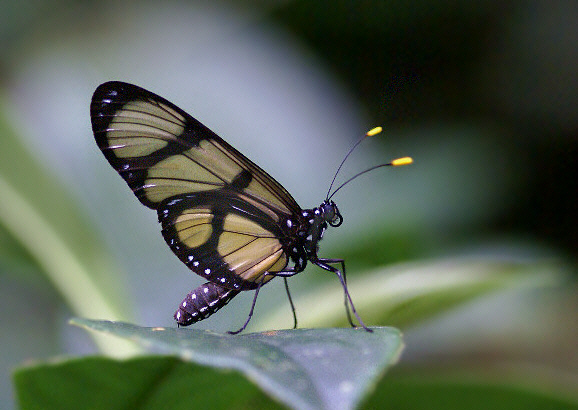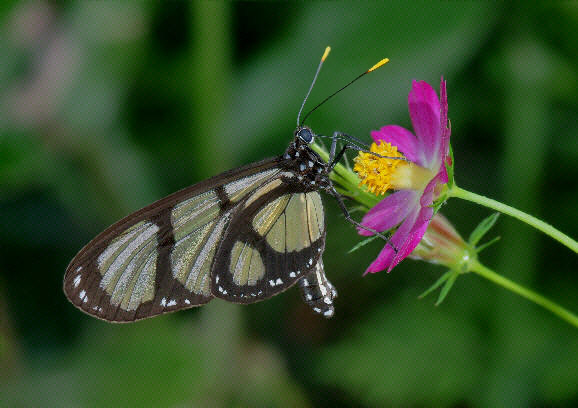
Introduction
The Ithomiini comprises of 376 known species, although it is likely that at least another 30 will be discovered in the near future. All are confined to the neotropical region. Ithomiines are unpalatable to birds, and are consequently mimicked in appearance by many other species. These include other unpalatable species ( Müllerian mimics ), not only from the Ithomiinae but also from several other butterfly families. There are also a large number of edible species ( Batesian mimics ) which have evolved similar patterns. Birds have the ability to memorise butterfly patterns and so learn to avoid eating noxious species, but are also fooled into ignoring similarly marked edible species.
Ithomiines are characterised by having small eyes, slender abdomens and long drooping antennae that lack distinct clubs. Males have a plume of long androconial scales or “hair pencils” on the costa of their hindwings. These are hidden from view when the butterflies are at rest, but are displayed when the wings are held open during courtship. Other Ithomiine characteristics include a very slow and deep wing beat, and a preference for inhabiting the darkest recesses of the forest understorey.
There are basically 2 types of Ithomiine. The first type are the black and orange-banded “tigers”, many of which are mimicked by other species due to their unpalatability to birds. The second type are the “glasswings”, recognised by their transparent or translucent wings, prominent veins, and orange wing margins. Many genera contain examples of both of these types, and in some cases an individual species may produce adults of both forms according to location.
Most novices find the Ithomiini very difficult to identify. Using only the patterns to identify species is very unreliable because there are so many similar species. Also many species produce a variety of different colour forms according to locality and season. The best approach therefore is to use the hindwing venation and other anatomical features to identify the genus, and to then look at the wing patterns to short-list the likely species.
The Giant Glasswings, which have wingspans of about 90-100mm, include 7 species of Methona and a single species of Thyridia. The 2 genera can be distinguished by the position of the dark cross-bar on the hindwing, which in Methona is further out from the base. Thyridia is noted for having shorter antennae, and a more squarish hyaline window occupying the basal half of the hindwings.
Habitats
Methona are primarily lowland butterflies, found in wet rainforest at altitudes between about 200-700m above sea level. They are usually encountered singly or in two’s and three’s, at light gaps in the denser parts of the interior.
Lifecycle
In Peru, in the late dry season, I observed a female Methona confusa ovipositing on an unidentified species of Solanaceae growing at the edge of a narrow forest track. The butterfly spent several minutes fluttering from leaf to leaf, “tasting” the leaves with its feet to determine the suitability of the plant. It eventually laid a single egg, which was large, globular, white and glistening, on the underside of a leaf.

Adult behaviour
Shortly after dawn both sexes undertake short migrations. They can often be seen at this time flying across rivers – e.g. I have observed this several times on the Rio Madre de Dios, Peru, in August and September ( late dry season ). During these flights they periodically pause to spend a few minutes nectaring at herbaceous plants on riverbanks or in forest glades.
Later in the morning as temperatures rise they retire to within the forest. Males are often seen at light gaps where fallen trees have opened the canopy and allow shafts of sunlight to penetrate to the forest floor. In such areas they perch on foliage, typically at heights between 2-3m, to await passing females.
I have never observed the pre-nuptial ritual, if one exists, but have found copulated pairs settled on low foliage at about midday. If disturbed they fly in tandem and resettle on higher foliage.
Females are active mainly in the late afternoon, when they slowly and very deliberately flit about from leaf to leaf searching for oviposition sites.
Both sexes settle with wings closed, but I have sometimes observed males slowly fanning their wings, possibly as a means of disseminating pheromones.
Towards the end of the dry season, the butterflies aggregate in the company of various other Ithomiine species, at dry riverbeds, where they gather at the remaining damp areas. At these times the butterflies can often be found around the base of palms, where they hide amongst the tent of rootlets.
